August 2021 Monthly Report
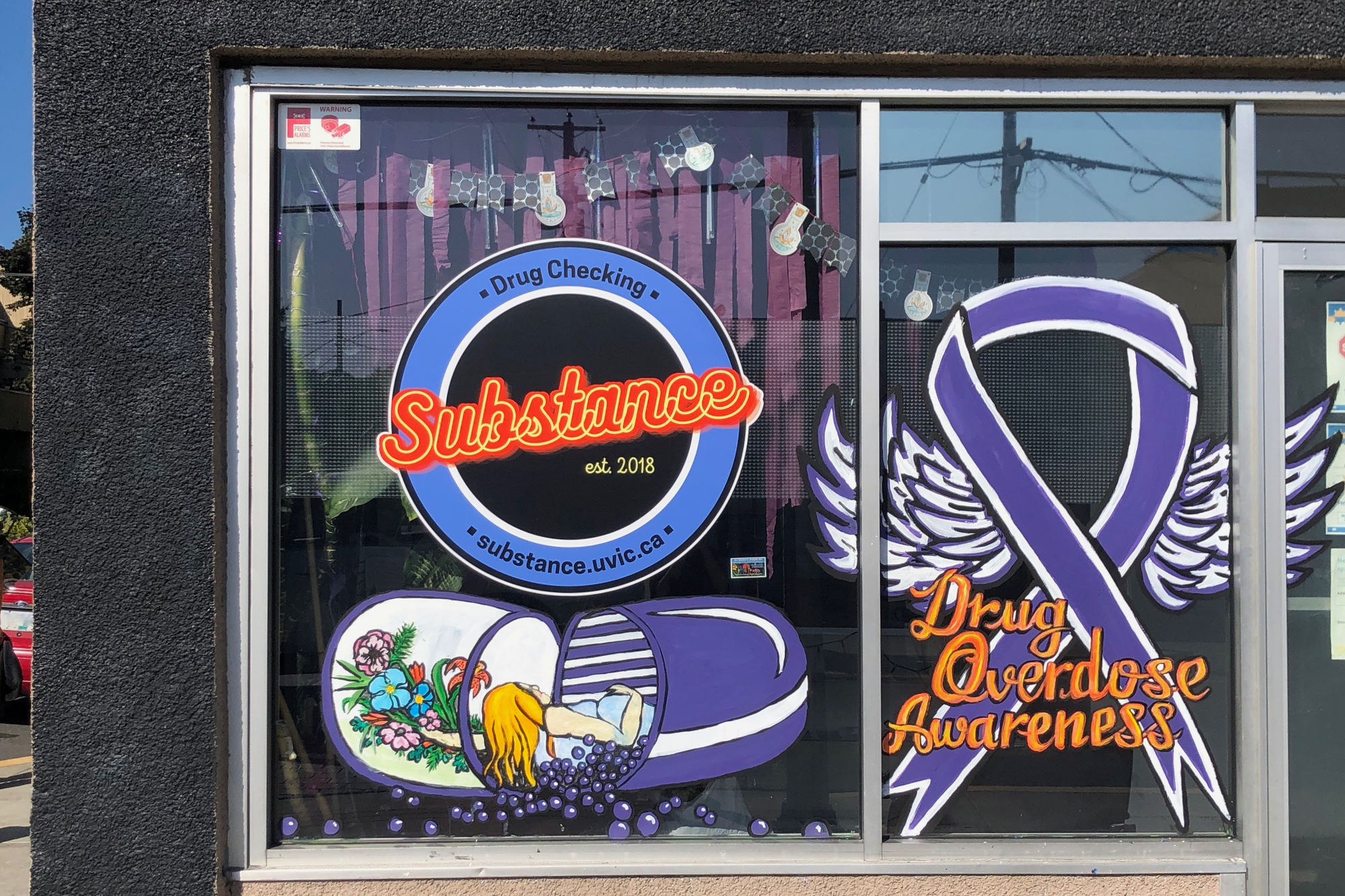
In this blog post we discuss our August 2021 report and provide more information on how to interpret the results. The PDF report can be found at the end.
Key findings:
- Carfentanil found in nine samples; eight expected to be opioid-down, one was unknown.
- Overall median fentanyl concentration of 8.1%, with a maximum concentration of 83.1% found in an expected opioid-down sample, our highest concentration sample to date.
- Overall median etizolam concentration of 2.0%, with a maximum concentration of 17.4% found in an expected opioid-down sample.
- Benzodiazepines and/or etizolam found in 47% of expected opioid-down samples, which is 11% higher than the previous month.
- TFMPP and 6-APDB were found in two expected MDMA samples.
Insight for the August 2021 Monthly Report
Drug checking is our service...and service is good! August was another busy month with 229 samples.
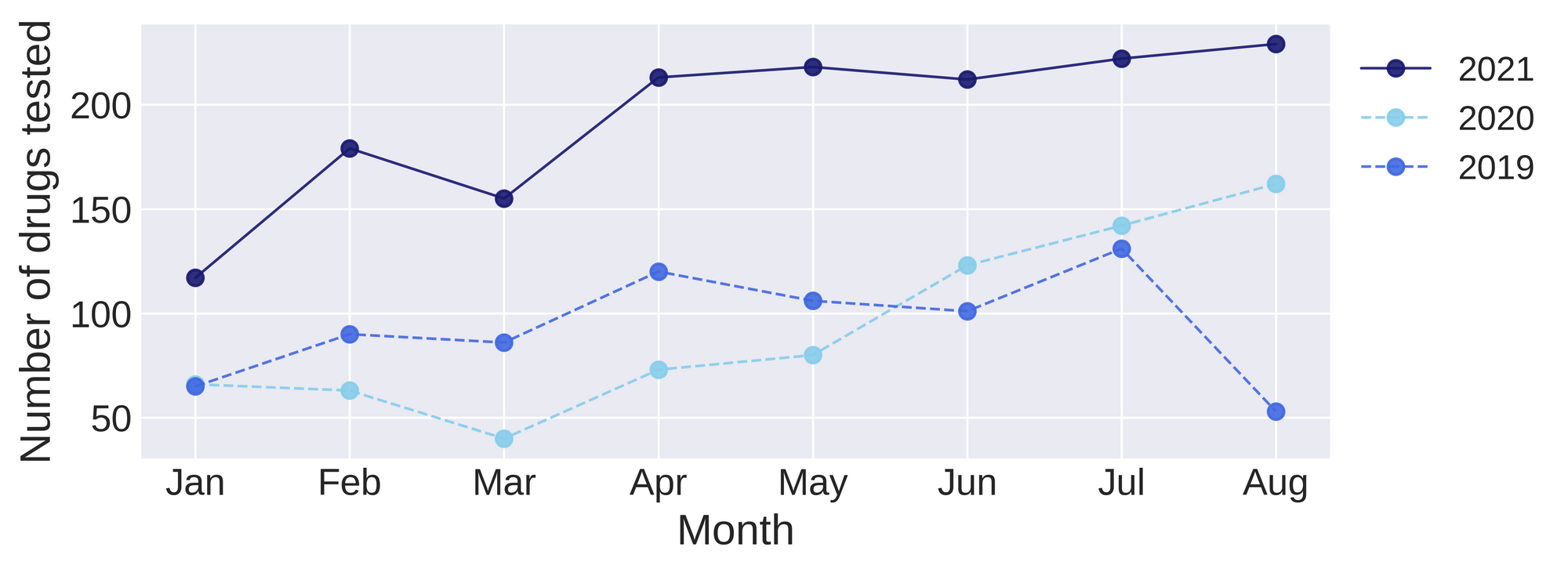
Drug types
We test a lot of different drugs each month; from DMT to fentanyl to ketamine. Fig. 2 shows the prevalence of each expected drug category checked each month, with opioids and stimulants continuing to be our most common samples checked.
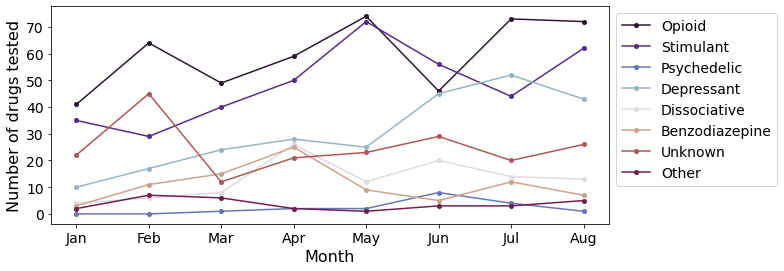
Not all the drugs we test are cut, buffed, or full of unexpected drugs. In many cases, we actually confirm that the expected drug was indeed the only expected active and that no additional cutting agents were present. The pie charts below differentiate when only the expected active was found from situations that would cause a sample to be unexpected.
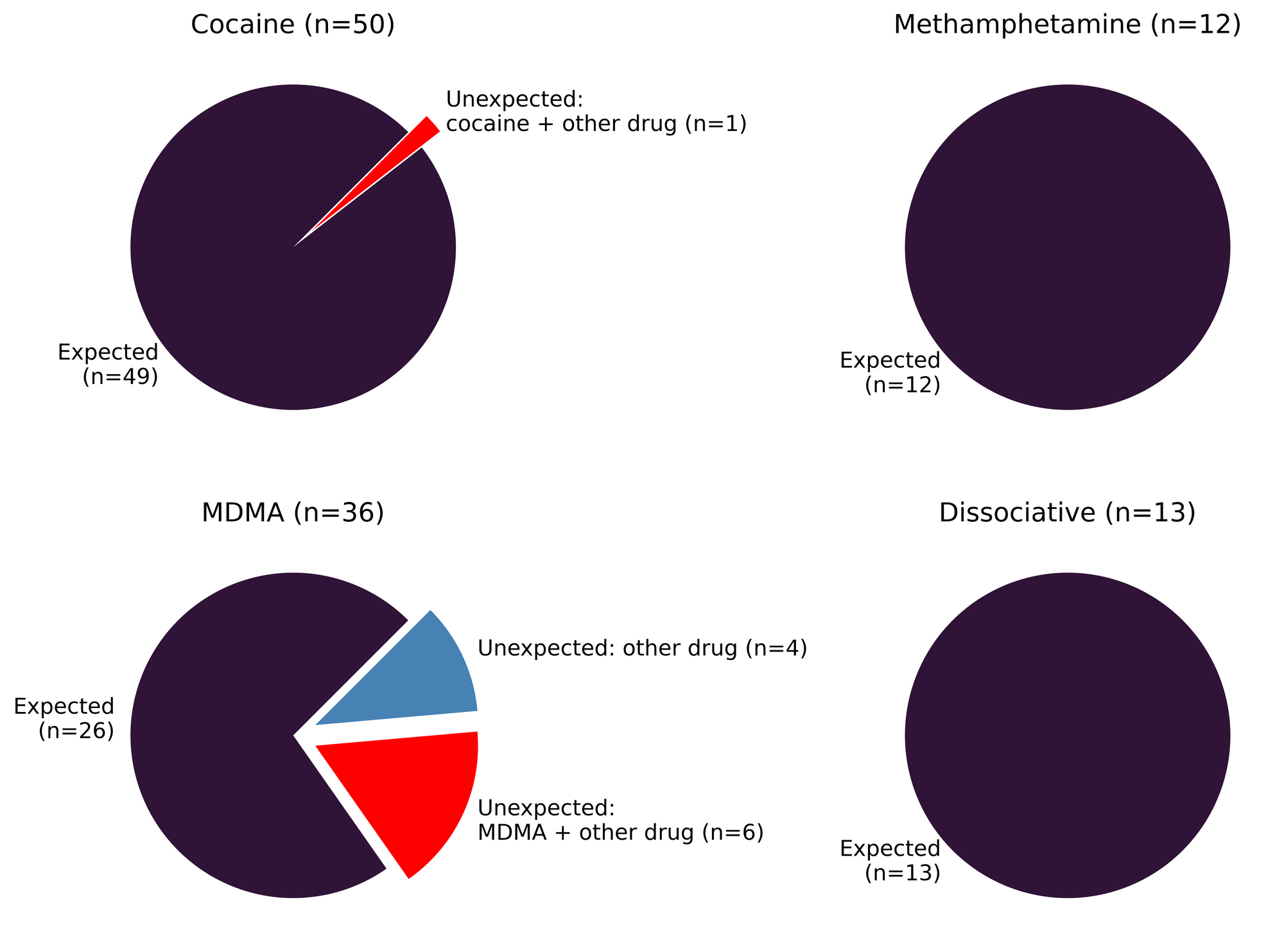
Curious about cuts?
For the 50 cocaine samples where cocaine was the only active drug present (a 66.6% increase from last month), only one sample contained a cut: phenacetin (acetaminophen-like substance). The remaining 98% of cocaine samples checked were found to contain cocaine as a single ingredient.
August was another month when we could reiterate a favourite phrase: meth is meth! 12 samples were checked where meth was the only expected active present, and no cuts were found in any of the samples.
MDMA and MDA continue to be merry mates. For the 33 MDMA samples where MDMA was the only expected active, 25 samples (76%) were found to have MDMA as a single ingredient. Of the remaining eight expected MDMA samples, four contained both MDMA and MDA, two contained only MDA, one contained MDMA + TFMPP (see below), and one contained MDA + 6-APDB (see below).
Three additional samples were checked where MDA was the only expected active. One sample was found to be MDA with no other cuts, one sample was found to be MDMA with no other cuts, and one sample was found to be MDA+MDMA (with no other cuts). Queue the confused math lady meme or maybe you don’t mind the minutiae between MDMA and MDA: of the 36 total samples expected to be MDMA and/or MDA, 34 (94%) samples were found to be MDMA and/or MDA with no other cuts. Despite the broad-strokes similarities between these enchanted entactogens, the longer duration and higher potency of MDA may maintain the motivation to meander our way to get your stuff checked.
All dissociatives checked this month were expected to be ketamine and all 13 were found to have ketamine as the only active, no other cuts were found.
Spotlight sample 1:
Despite wanting to take a nap after the exhaustion of typing out its name, 3-Trifluromethylphenylpiperazine (TFMPP) is a stimulant of the piperazine class of drugs and is often taken with benzylpiperazine (BZP; see last month’s Spotlight Sample 1) to produce MDMA-like effects. TFMPP was found this month in an expected MDMA sample, along with MDMA. Read more here.
Spotlight sample 2:
Continuing with the entactogenic research chemicals found in expected MDMA samples, August also introduced our instruments to 6-APDB. Less casually known as 6-(2-aminopropyl)-2,3-dihydrobenzofuran or 4-Desoxy-MDA, 6-APDB is a synthetic analogue of MDA, though with anecdotally less stimulating effects. This sample was found alongside MDA in a cloudy crystal expected to be MDMA.
Benzodiazepines (n=7)
Though we continue to hear a lot about benzodiazepine adulteration in the opioid down supply, there are many substances brought to our service that are expected to be a benzo as a single ingredient. Usually these are brought in as a tablet, though interestingly enough one sample was brought in on a paper tab/blotter.
Two of the benzo samples were expected to be diazepam (Valium) as a single ingredient, and only diazepam was found with no other cuts. These are the first two diazepam samples we have seen in the roughly 1800 samples we have checked.
The remaining five benzo samples were found to not contain the expected active drug. Three samples did not contain any active substances and were only inert cuts, one sample was found to be etizolam in an expected alprazolam (Xanax) sample, and flualprazolam was found in an unknown expected benzo sample.
Spotlight sample 3:
Ratatat’s “Wildcat” is driving softly in the background, you just finished a grrreat bowl of frosted flakes, and it’s time to mellow the anxieties of your fierce inner beast - possibly the scene imagined by the artist responsible for creating the funkadelic tiger stripe print found on this flualprazolam blotter tab. Benzos on blotter is new to us.
Opioid-Down (n=68)
In this section we present statistics specific to the opioid-down supply, therefore they may differ from the highlighted findings above that are inclusive of all expected drug categories.
- 82% expected opioid-down samples contained fentanyl (56/68)
- 12% samples contained carfentanil (8/68)
- 47% samples contained a benzo and/or etizolam (32/68)
This August, 66% of opioid down samples contained an additional active to the expected fentanyl and/or heroin, with benzo-related drugs being the major contributor. This category represents the complex opioid down supply when adulterants are present, which is different from misrepresented samples where no expected active is found. Figure 4 illustrates the consistently high percentage of adulterants found in opioid down over time, highlighting the ever-changing conditions of prohibited markets. The only consistency we have is in knowing that each month there will be a high level of inconsistencies in the supply. People who use drugs have been pointing to the remedies to this unregulated supply for years, with calls for decriminalization and safer supply as effective interventions in the unregulated market. It’s long past time we listen.
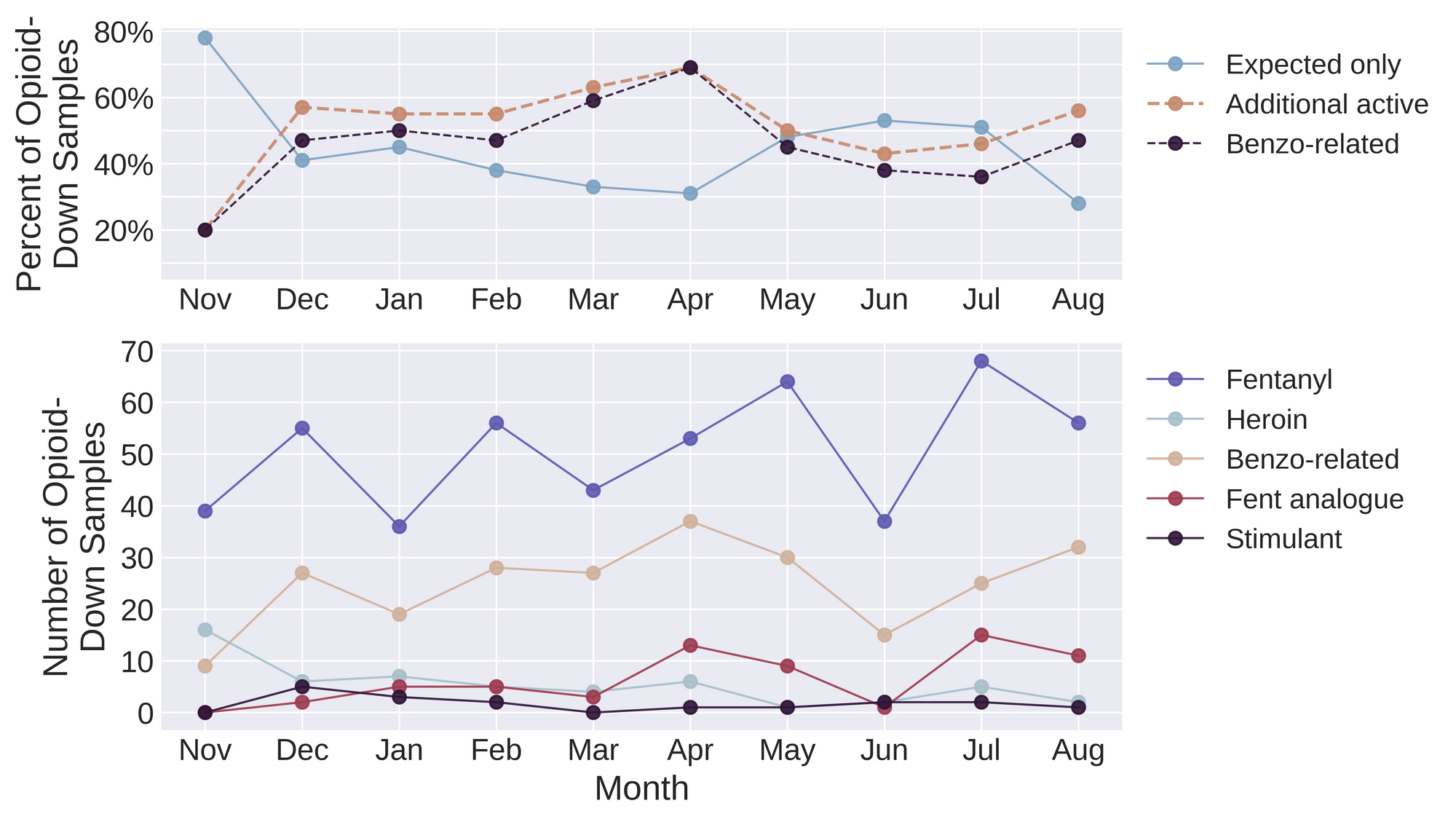
Quantification for Expected Opioid-Down

In August, we quantified fentanyl for 57/68 of the opioid down samples containing fentanyl and found the median concentration to be 8.1%, with the average strength of fentanyl we normally see being around 10%. Though the median is a useful indicator, it doesn’t capture the volatility of fentanyl concentrations present in the opioid supply, as any one sample might be the lowest strength (0.1%) or the strongest (83.1%). Figure 3 demonstrates the spread of concentrations we found in August by week (left) and for the month overall (right).
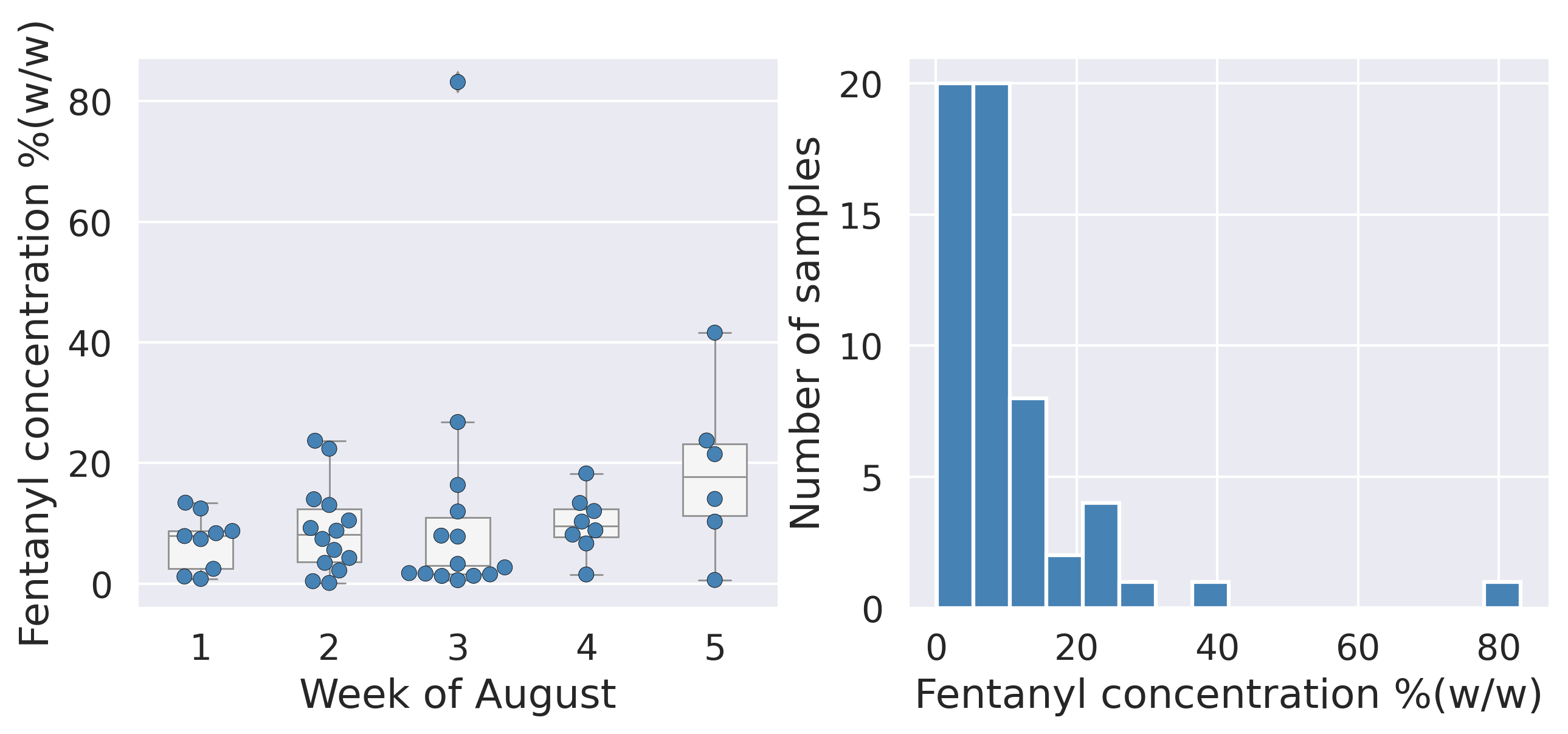
Want to be notified when we release these reports? Join our mailing list to receive updates about when our reports are out. You can subscribe and unsubscribe yourself from this list at any time.
Check back next month for the September report!
As always, send us feedback at substance@uvic.ca for how we can continue to offer our drug checking results in a useful way.
